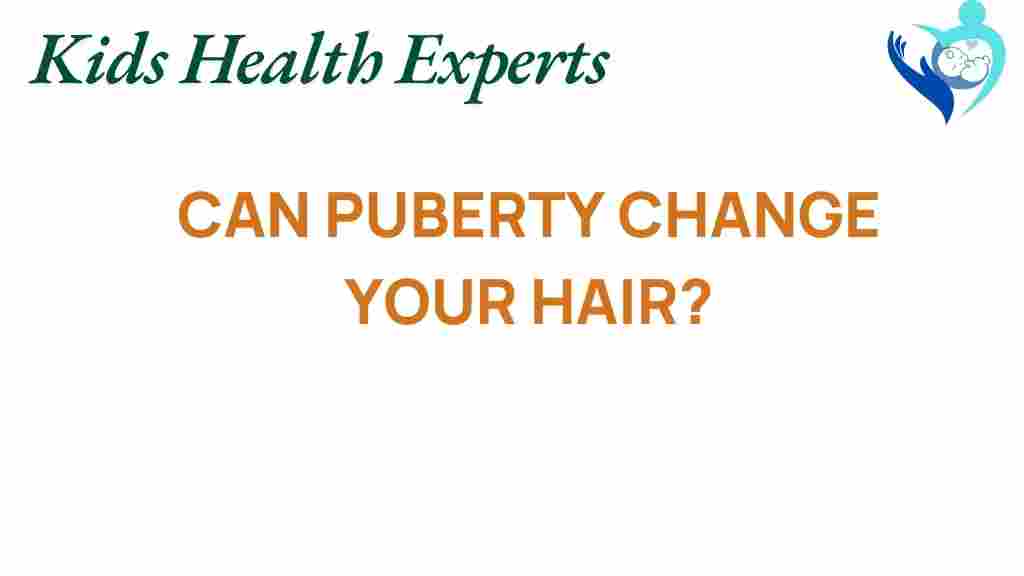Unraveling the Mysteries: Does Puberty Transform Your Hair?
As we journey through adolescence, one of the most notable physical transformations occurs with our hair. The onset of puberty brings about a multitude of changes influenced by the complex interplay of hormones, genetics, and overall health. In this article, we will delve into how puberty impacts hair growth, texture, and scalp health, while also addressing common concerns and providing tips for managing these changes.
The Science Behind Hair Changes During Puberty
Understanding how puberty affects hair requires a grasp of the biological processes at play. Here are the key factors involved in this transformation:
- Hormonal Fluctuations: During puberty, the body undergoes significant hormonal changes, particularly an increase in sex hormones like testosterone and estrogen. These hormones have a direct effect on hair follicles, stimulating hair growth and altering hair characteristics.
- Genetics: Your genetic makeup plays a crucial role in how your hair responds to hormonal changes. Family history can determine hair density, texture, and growth patterns.
- Scalp Health: The health of your scalp is vital for hair growth. Hormonal changes can lead to increased oil production, affecting scalp health and hair appearance.
Hair Growth Phases During Adolescence
Hair growth occurs in cycles, and during adolescence, these cycles may be altered due to hormonal changes:
- Anagen Phase: This is the active growth phase where hair follicles are producing new hair. During puberty, this phase may be prolonged, resulting in faster hair growth.
- Catagen Phase: This transitional phase lasts a few weeks and signals the end of the active growth. Hormonal shifts can affect how long hair remains in this phase.
- Telogen Phase: The resting phase where hair falls out. Increased stress and hormonal changes can lead to excessive shedding during this stage.
Common Hair Changes During Puberty
As one navigates through adolescence, various hair changes may be observed:
- Increased Hair Growth: Many teenagers experience an increase in body hair, including facial hair in boys and underarm and pubic hair in both genders.
- Texture Changes: Hair may become thicker, curlier, or straighter due to hormonal effects on the hair follicles.
- Oil Production: Increased oil production can lead to greasier hair, often necessitating more frequent washing.
- Scalp Issues: Hormonal changes can result in conditions such as dandruff or acne on the scalp, affecting overall hair health.
Managing Hair Changes During Puberty
While the changes that come with puberty are natural, there are ways to manage and maintain healthy hair:
1. Establish a Hair Care Routine
Consistency is key in maintaining healthy hair. Here’s how to create a simple routine:
- Regular Washing: Use a gentle shampoo suited for your hair type to avoid excessive oil buildup.
- Conditioning: Use conditioner to keep hair moisturized and manageable.
- Scalp Care: Consider using products that promote a healthy scalp to prevent dandruff and other issues.
2. Nutrition and Hair Health
A balanced diet rich in vitamins and minerals is essential for healthy hair growth. Focus on:
- Protein: Hair is primarily made of protein, so include lean meats, legumes, and dairy in your diet.
- Vitamins: Vitamins A, C, D, E, and B-complex vitamins are crucial for hair health.
- Omega-3 Fatty Acids: These help nourish hair follicles and promote healthy growth.
3. Avoiding Damage
To maintain hair integrity during adolescence, it is important to minimize damage:
- Heat Protection: Use heat-protectant products when styling hair with heat tools.
- Gentle Styling: Avoid tight hairstyles that can lead to breakage.
- Regular Trims: Schedule regular haircuts to eliminate split ends and promote healthy growth.
Troubleshooting Common Hair Issues
During puberty, you may encounter various hair-related issues. Here are some common problems and solutions:
1. Excessive Oiliness
If you find your hair is overly greasy, consider:
- Using a clarifying shampoo once a week to remove buildup.
- Avoiding heavy conditioners that can weigh hair down.
- Incorporating dry shampoo to absorb excess oil between washes.
2. Hair Shedding
It’s normal to lose some hair, but excessive shedding may signal a problem. To address this:
- Ensure you are eating a well-balanced diet.
- Manage stress through relaxation techniques or physical activity.
- If shedding persists, consult a healthcare professional to rule out any underlying conditions.
3. Dandruff and Scalp Irritation
If you experience dandruff, consider the following:
- Use anti-dandruff shampoos with active ingredients like zinc pyrithione or ketoconazole.
- Keep your scalp moisturized with natural oils like coconut oil.
- Limit the use of hair products that can irritate the scalp.
Conclusion
The journey through puberty is filled with changes, and hair transformations are among the most visible. Understanding how hormones, genetics, and scalp health interplay during this time can help you navigate the challenges of hair care in adolescence. By establishing a solid hair care routine, maintaining a nutritious diet, and addressing common issues proactively, you can embrace and manage the changes that come with this exciting developmental phase.
For more insights on hair care during teenage development, check out our other articles here. If you’re looking for professional advice, consider consulting a dermatologist or a trichologist for personalized support here.
This article is in the category Conditions and created by KidsHealthExperts Team
